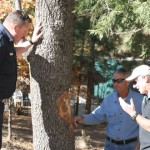
Prior to discovery of the tree, just across Highway 243 from the Italian restaurant La Bella Montagna, the northernmost reach of the highly destructive GSOB was thought to be northern San Diego County, about 40 miles from Idyllwild. Authorities believe the beetles, which share the same genetic characteristics as those in San Diego that have caused such a swath of destruction, were transported in firewood.
CAL FIRE Chief Gregg Bratcher, new agency San Jacinto Mountains forester and Dr. Tom Scott, natural resource specialist, University of California Riverside, were on hand for the felling of the tree by CAL FIRE crews. Scott has been one of the lead scientists in tracking the GSOB spread and destructive path.

GSOB is not native to California. It’s native habitats, where it has been ensconced for many years and held in check by natural predators, is in Guatamala, Mexico and southeastern Arizona. Because it is not native to California, there are no natural predators here to check its spread. Nor are there, at this time, any effective topical pesticides that could arrest its advance.
“This tree was probably already in a lot of trouble [from other pests and funguses] before being hit by GSOB,” said Scott. “It has a lot of beetles in it and would have died no matter what.”
The issue becomes, as Bratcher acknowledged, the coordination of a multi agency response to identify additional infected Hill trees and creation of an effective public education campaign regarding cutting and transportation of firewood, and ways to curtail further spread of the predator.

The tree cross sections Scott examined after the tree came down will be taken off the Hill to labs in quarantined areas of San Diego County. “By forensically examining it [tree cross sections] we can assign times when the top died and figure out whether the tree was first in trouble [from other pathogens] or whether the beetle killed it,” said Scott. He observed that people in the mountains still need to use firewood, but the issue becomes how to stop movement of diseased wood in a reasonable way.
Bratcher estimated that a rapid response survey of trees in the area of the infected oak would likely begin next week.















let's not over think this for 10 years in research, and $20 million in analysis.
it looks like an insect between a roach or a grasshopper.
Birds eat bugs. Idyllwild has birds. problem solved.
http://gsob.wikispaces.com/file/view/01_goldspott…
Hmmmm. Simplistic and inaccurate. All the infections come from places with lots of birds. Problem NOT solved.
so you are saying that a Stellar jay or Woodpecker would go hungry instead of pick at this bug? it's not poisonous.
Fire Ants are now old news and the hype is played out.
Looks like a new hidden property tax sneaking in.
[…] news again Wednesday, Nov. 14, as Cal Fire reported an infested tree found in Idyllwild. The weekly Idyllwild Town Crier newspaper documented the cutting down of the estimated 140-year-old California black oak tree, a short walk southwest of […]
An informative Goldspotted Oak Borer workshop is being held in Fallbrook Ca. on December 4th a Tuesday from 9–12 noon
It is free and open to the general public,
You all are invited to attend to learn more about this dreaded bug and what is being done.
Contact Jan Gonzales @ 858 614-7624 to pre- register.